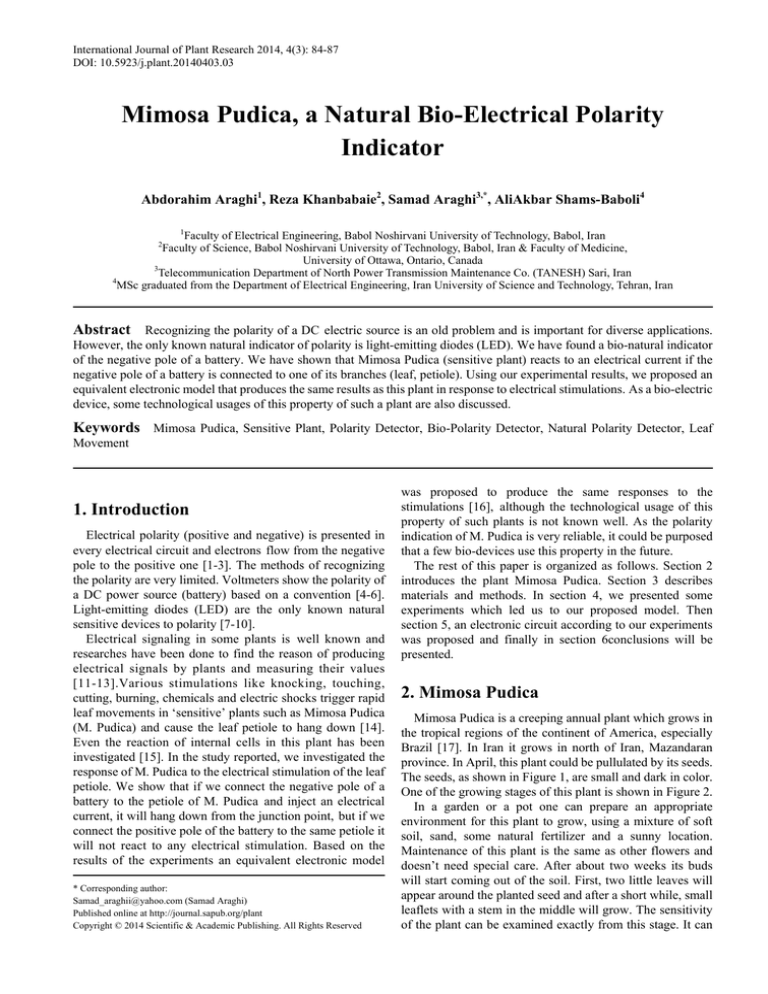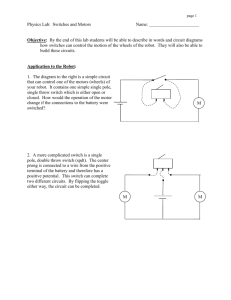
International Journal of Plant Research 2014, 4(3): 84-87
DOI: 10.5923/j.plant.20140403.03
Mimosa Pudica, a Natural Bio-Electrical Polarity
Indicator
Abdorahim Araghi1, Reza Khanbabaie2, Samad Araghi3,*, AliAkbar Shams-Baboli4
1
Faculty of Electrical Engineering, Babol Noshirvani University of Technology, Babol, Iran
Faculty of Science, Babol Noshirvani University of Technology, Babol, Iran & Faculty of Medicine,
University of Ottawa, Ontario, Canada
3
Telecommunication Department of North Power Transmission Maintenance Co. (TANESH) Sari, Iran
4
MSc graduated from the Department of Electrical Engineering, Iran University of Science and Technology, Tehran, Iran
2
Abstract Recognizing the polarity of a DC electric source is an old problem and is important for diverse applications.
However, the only known natural indicator of polarity is light-emitting diodes (LED). We have found a bio-natural indicator
of the negative pole of a battery. We have shown that Mimosa Pudica (sensitive plant) reacts to an electrical current if the
negative pole of a battery is connected to one of its branches (leaf, petiole). Using our experimental results, we proposed an
equivalent electronic model that produces the same results as this plant in response to electrical stimulations. As a bio-electric
device, some technological usages of this property of such a plant are also discussed.
Keywords Mimosa Pudica, Sensitive Plant, Polarity Detector, Bio-Polarity Detector, Natural Polarity Detector, Leaf
Movement
1. Introduction
Electrical polarity (positive and negative) is presented in
every electrical circuit and electrons flow from the negative
pole to the positive one [1-3]. The methods of recognizing
the polarity are very limited. Voltmeters show the polarity of
a DC power source (battery) based on a convention [4-6].
Light-emitting diodes (LED) are the only known natural
sensitive devices to polarity [7-10].
Electrical signaling in some plants is well known and
researches have been done to find the reason of producing
electrical signals by plants and measuring their values
[11-13].Various stimulations like knocking, touching,
cutting, burning, chemicals and electric shocks trigger rapid
leaf movements in ‘sensitive’ plants such as Mimosa Pudica
(M. Pudica) and cause the leaf petiole to hang down [14].
Even the reaction of internal cells in this plant has been
investigated [15]. In the study reported, we investigated the
response of M. Pudica to the electrical stimulation of the leaf
petiole. We show that if we connect the negative pole of a
battery to the petiole of M. Pudica and inject an electrical
current, it will hang down from the junction point, but if we
connect the positive pole of the battery to the same petiole it
will not react to any electrical stimulation. Based on the
results of the experiments an equivalent electronic model
* Corresponding author:
Samad_araghii@yahoo.com (Samad Araghi)
Published online at http://journal.sapub.org/plant
Copyright © 2014 Scientific & Academic Publishing. All Rights Reserved
was proposed to produce the same responses to the
stimulations [16], although the technological usage of this
property of such plants is not known well. As the polarity
indication of M. Pudica is very reliable, it could be purposed
that a few bio-devices use this property in the future.
The rest of this paper is organized as follows. Section 2
introduces the plant Mimosa Pudica. Section 3 describes
materials and methods. In section 4, we presented some
experiments which led us to our proposed model. Then
section 5, an electronic circuit according to our experiments
was proposed and finally in section 6conclusions will be
presented.
2. Mimosa Pudica
Mimosa Pudica is a creeping annual plant which grows in
the tropical regions of the continent of America, especially
Brazil [17]. In Iran it grows in north of Iran, Mazandaran
province. In April, this plant could be pullulated by its seeds.
The seeds, as shown in Figure 1, are small and dark in color.
One of the growing stages of this plant is shown in Figure 2.
In a garden or a pot one can prepare an appropriate
environment for this plant to grow, using a mixture of soft
soil, sand, some natural fertilizer and a sunny location.
Maintenance of this plant is the same as other flowers and
doesn’t need special care. After about two weeks its buds
will start coming out of the soil. First, two little leaves will
appear around the planted seed and after a short while, small
leaflets with a stem in the middle will grow. The sensitivity
of the plant can be examined exactly from this stage. It can
International Journal of Plant Research 2014, 4(3): 84-87
close its leaves when touched and bend downward.
85
roots. At the end, only one or two bushes are enough for each
pot. The roots which are taken out of the pot could be used
for planting in other places.
Mimosa Pudica gives flowers in July. The flowers are
purple and they are as big as a small strawberry (Figure 3).
The flowers gradually change into seeds at the end of autumn
and by the start of cold winter the plant will die.
3. Materials and Methods
Figure 1. Mimosa Pudica seeds
Figure 2. One stage of Mimosa Pudica growth
Plants were cultivated from seeds in natural day light at
20-30℃. At the time of the experiments, the plants were
about 90 days old. In order to stimulate the petiole of the
plants which you can see in figure 4, we used an electrical
circuit containing a 9 Volt battery, a regular switch, a 330 kΩ
resistor and two electrodes in series. The electrical
connection to the petiole was done using a tungsten needle
electrode penetrating through the branch. Figure 4 shows the
electrical circuit devices used in our experiments to stimulate
the plant petiole. We have measured this current with a
digital multimeter as Idc = 5.1 µA. The experiments were
repeated in 30 different days in summer to check the
reliability of the results.
In the model experiment we used an ordinary diode
(1N4001) and a LED. The battery was 9 Volt and the resistor
was 680 Ω. The current passing through the circuit was about
10 mA.
Figure 3. Branches, leaves, and flowers of Mimosa Pudica
During the growing of Mimosa Pudica it is better to keep
the best growing buds and take the rest out of soil from their
Figure 4. Electrical circuit
86
Abdorahim Araghi et al.:
Mimosa Pudica, a Natural Bio-Electrical Polarity Indicator
4. Experiments
An electrical circuit was prepared with a battery, a switch,
a resistor and two electrodes (Figure 4). The negative pole of
the battery was connected to a petiole on the right side of the
plant and the positive pole was connected to another petiole
on the left side of the plant (Figure 5A). A few seconds
(about 3 seconds) after closing the switch the negative side
petiole hanged down from its junction point to the stem
(Figure 5B).
Figure 6. Negative pole connected to the left petiole, A. The sensitive
plant before electrical stimulation, B. The sensitive plant after stimulation.
The petiole connected to the negative pole of the battery is hanged down
5. Proposed Model
Figure 5. Negative pole connected to the right petiole, A. The sensitive
plant before electrical stimulation, B. The plant after stimulation. The
petiole connected to the negative pole of the battery is hanged down
To let the bent branch return completely to its normal
position we waited about 30 minutes. Then we changed the
polarity of the battery and connected the positive pole to the
right hand side petiole and the negative pole to the one on the
left (Figure 6A). The petiole connected to the negative pole
of the battery (the left side branch) hanged down again after a
few seconds (Figure 6B).
These two experiments indicate that the M. Pudica is
sensitive to the negative pole of a DC source and can easily
recognize the positive and negative pole of a battery. These
experiments were repeated carefully in different days and
different nights and the results were the same [16]. The
precision of the reaction was better in days than nights in
which the plant was in the sleeping mode.
Figure 7. Electronic circuit simulates the bio-circuit, A. The negative pole
of the battery is connected to the right set of two diodes. B. The negative
pole of the battery is connected to the left set of two diodes
International Journal of Plant Research 2014, 4(3): 84-87
Based on our experiments and the results, we can compare
the bio-circuit of the plant to an electronic circuit like figure
7. In this figure we replaced each junction of the petiole to
the stem with a set of two diodes one of which is an ordinary
diode and the other one is an LED. If we connect the negative
pole of the battery to the right hand side branch of these two
sets of diodes only the right LED will light up (Figure 7A)
and if we connect the negative pole of the battery to the left
branch only the left LED will light up (Figure 7B). This
behavior is comparable to the behavior of the bio-circuit of
the plant. So we could use it as a negative pole Bio-detector.
6. Conclusions
We have shown that the Mimosa Pudica as a natural
device can recognize the polarity of a battery and react
clearly when we connect the negative pole of a battery to its
petiole. Also this phenomenon can be used as a standard test
to recognize and study other sensitive plants. This study can
help to develop a method to test the reaction of live animals
or plants to the positive and negative pole of a battery or to
external electrical signals.
The theory of motion of electrons or ions in an electrical
circuit has been taught in classes for many years, but we do
not have a simple tool to show the direction of the motion of
the electrons. This phenomenon can be used as a simple but
reliable tool to show the direction of the motion of the
electrons. We can also use this behavior to indicate the
motion of ions in electrolytes in chemical reactions and
electrolysis.
REFERENCES
[1]
Heng Yao, Qiangyi Xu and Ming Yuan, Plant Signaling &
Behavior, 3:11, pp. 954-960, November 2008.
[2]
Morris S. Alan, Measurement and Instrumentation Principles,
Third Edition [Kindle Edition], 2001.
[3]
Van Bel A.J.E., Ehlers K. Electrical Signaling via
Plasmodesmata. In Plasmodesmata (ed. K.J. Oparka),
87
Blackwell Publishing, Oxford, UK, pp. 263-278, 2004.
[4]
Hodgkin A, Huxley A, A Quantitative Description of
Membrane Current and Its Application to Conduction and
Excitation in Nerve. J. Physiol. 117, pp. 500-544, 1952.
[5]
Volkov, A. G., Foster, J. C., Ashby, T. A., Walker, R. K.,
Johnson, J. A. and Markin, V. S., Mimosa pudica: Electrical
and mechanical stimulation of plant movements. Plant, Cell
& Environment, 33:163-173.doi:10.1111/j.1365-3040, 2009.
02066.x, 2010.
[6]
Fromm, J. and Lautner, S., Electrical signals and their
physiological significance in plants. Plant, Cell &
Environment, 30: pp. 249-257. doi:10.1111/j.1365-3040.200
6.01614.x, 2007.
[7]
Abe T., Chloride Ion Efflux during an Action Potential in the
Main Pulvinus of Mimosa Pudica. Botanical Magazine Tokyo,
pp. 379-383, 1981.
[8]
Heng Yao, Qiangyi Xu and Ming Yuan, Plant Signaling &
Behavior 3:11, pp. 954-960, November 2008.
[9]
Morris S. Alan, Measurement and Instrumentation Principles,
Third Edition [Kindle Edition], 2001.
[10] Van Bel A.J.E., Ehlers K., Electrical signaling via
plasmodesmata. In Plasmodesmata (ed. K.J. Oparka), pp.
263-278, Blackwell Publishing, Oxford, UK, 2004.
[11] Hille B., Ionic channels of excitable memberanes. Sinauer
Associates, Inc. Publisher Sunderland, MA, USA, 1992.
[12] Hodgkin A, Huxley A., A quantitative description of
membrane current and its application to conduction and
excitation in nerve. J. Physiol. 117, pp. 500-544, 1952.
[13] Bonnen J. and Gal Ston A. W., Principles of Plant Physiology,
Freeman, San Francisco, 1952.
[14] Ismaeel Zahedi, Physiology of Plant Growth and Movements,
University of Tehran press, pp.187-195, 1963.
[15] Abdolrahim Araghi, Physical Behaviors of Sensitive Plant to
the External Stimulations, Iran Physics Conference, Abstract,
pp. 25-33, 1992.
[16] Abdolrahim Araghi, Scientific Observations, Mohamed
publications, pp. 11-25, 2005.
[17] Abdolrahim Araghi, Mimosa Pudica: Prevent and Control the
Spread of Electrical Signals inside the Mimosa Pudica,
Abdolrahim Araghi Publications, pp. 13-16, 2013.




